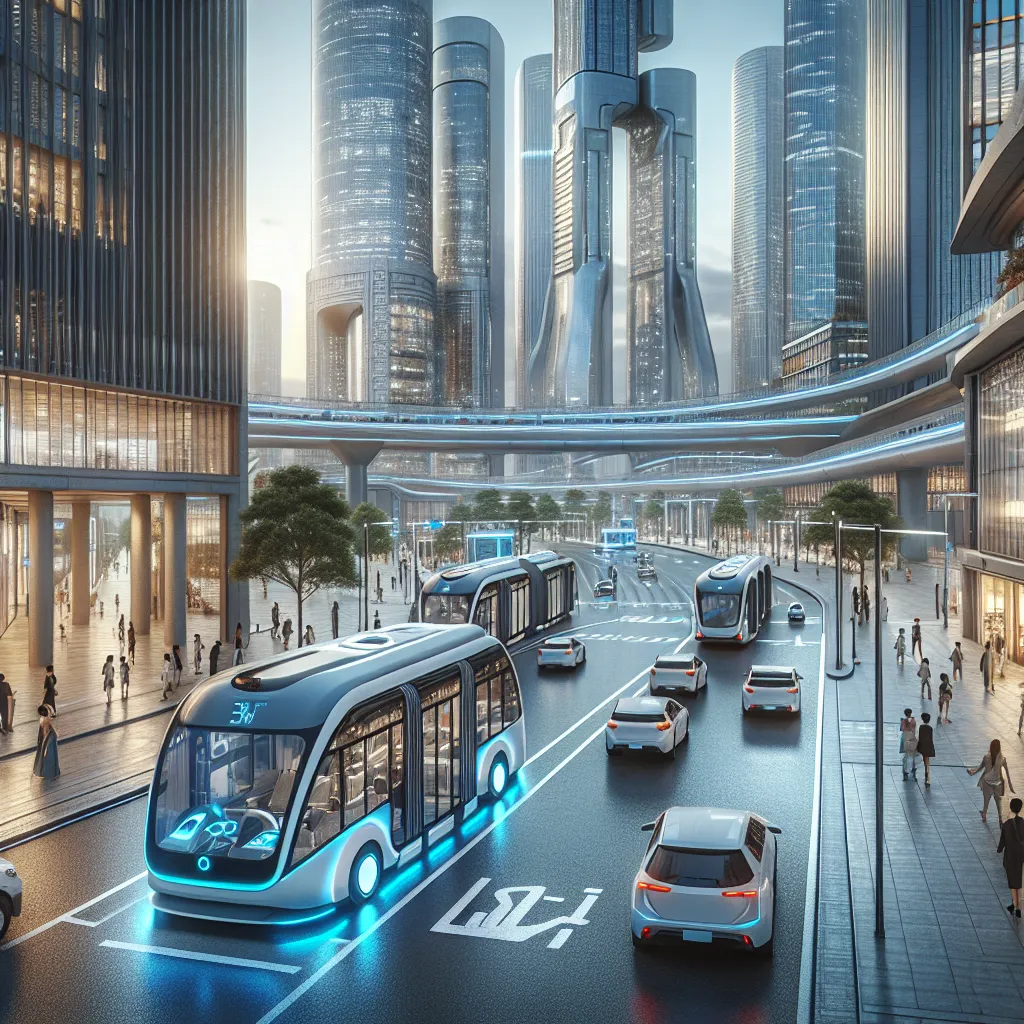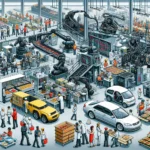Are you preparing for the IELTS Reading test and looking to improve your skills? Look no further! In this comprehensive practice test, we’ll explore the fascinating topic of “The Future of Autonomous Vehicles in Public Transport” while honing your reading comprehension abilities. As an experienced IELTS instructor, I’ve crafted this test to closely resemble the actual IELTS Reading exam, complete with three passages of increasing difficulty and a variety of question types. Let’s dive in and challenge your reading skills!
 Autonomous vehicles in public transport
Autonomous vehicles in public transport
Passage 1 – Easy Text
The Rise of Autonomous Vehicles in Public Transportation
Autonomous vehicles are revolutionizing the way we think about public transportation. These self-driving vehicles, equipped with advanced sensors and artificial intelligence, are poised to transform urban mobility in the coming decades. Cities around the world are exploring the potential of autonomous buses, shuttles, and trams to improve efficiency, safety, and accessibility in public transit systems.
One of the primary advantages of autonomous vehicles in public transport is increased safety. By eliminating human error, which accounts for a significant percentage of traffic accidents, these vehicles have the potential to drastically reduce collision rates. Additionally, autonomous vehicles can operate 24/7 without fatigue, potentially increasing the availability and frequency of public transportation services.
Efficiency is another key benefit of autonomous public transport. These vehicles can communicate with each other and with traffic infrastructure, optimizing routes and reducing congestion. This improved efficiency could lead to shorter travel times and decreased energy consumption, contributing to more sustainable urban environments.
Accessibility is also enhanced with autonomous vehicles. For elderly or disabled individuals who may have difficulty using traditional public transportation, autonomous vehicles offer a more convenient and independent travel option. These vehicles can be designed with features such as low floors and wheelchair ramps, making them accessible to a wider range of passengers.
However, the implementation of autonomous vehicles in public transport is not without challenges. Regulatory frameworks need to be developed to ensure the safe operation of these vehicles on public roads. Additionally, there are concerns about cybersecurity and the potential for hacking of autonomous systems. Public acceptance is another hurdle, as some people may be hesitant to trust their safety to a self-driving vehicle.
Despite these challenges, many experts believe that autonomous vehicles will play a significant role in the future of public transportation. As technology continues to advance and regulatory issues are addressed, we can expect to see more cities adopting autonomous buses, shuttles, and other forms of public transit in the coming years.
Questions 1-7
Do the following statements agree with the information given in the passage?
Write:
TRUE if the statement agrees with the information
FALSE if the statement contradicts the information
NOT GIVEN if there is no information on this
- Autonomous vehicles in public transport are expected to improve urban mobility.
- Human error is a major cause of traffic accidents.
- Autonomous vehicles can operate continuously without breaks.
- Self-driving public transport vehicles are more expensive to maintain than traditional ones.
- Autonomous vehicles can help reduce traffic congestion in cities.
- Elderly and disabled individuals may benefit from autonomous public transportation.
- All cities have already adopted autonomous vehicles for public transport.
Questions 8-10
Complete the sentences below.
Choose NO MORE THAN TWO WORDS from the passage for each answer.
- One of the main challenges in implementing autonomous vehicles is developing appropriate .
- There are concerns about the potential for ___ of autonomous vehicle systems.
- Many experts believe autonomous vehicles will have a ___ role in future public transportation.
Passage 2 – Medium Text
The Impact of Autonomous Vehicles on Urban Planning and Infrastructure
The advent of autonomous vehicles in public transportation is not only transforming the way we travel but also reshaping urban planning and infrastructure. As cities prepare for this technological revolution, urban planners and policymakers are faced with the challenge of adapting existing infrastructure and designing new spaces that can accommodate and optimize the use of self-driving vehicles.
One of the most significant impacts of autonomous vehicles on urban planning is the potential reduction in parking space requirements. Traditional public transportation systems often require large areas for bus depots and parking lots. However, autonomous vehicles can be programmed to continuously circulate or return to centralized hubs when not in use, potentially freeing up valuable urban real estate for other purposes such as green spaces, housing, or commercial development.
Traffic flow optimization is another area where autonomous vehicles are expected to have a profound impact. By communicating with each other and with smart traffic management systems, these vehicles can coordinate their movements to reduce congestion and improve overall traffic efficiency. This could lead to a reduction in the number of lanes required on roads, allowing for the expansion of pedestrian areas and bicycle lanes.
The integration of autonomous vehicles into public transportation systems also necessitates the development of new infrastructure. Charging stations for electric autonomous vehicles will need to be strategically placed throughout cities. Additionally, dedicated lanes or corridors for autonomous vehicles may be implemented to ensure their safe and efficient operation alongside traditional vehicles during the transition period.
Data infrastructure is another critical component that cities must consider. Autonomous vehicles generate vast amounts of data that can be used to optimize routes, predict maintenance needs, and improve overall system efficiency. Cities will need to invest in robust data management systems and analytics capabilities to harness the full potential of this information.
The shift towards autonomous public transportation also has implications for urban design at the street level. As the need for traditional bus stops and signage decreases, cities have the opportunity to redesign streetscapes to be more pedestrian-friendly and aesthetically pleasing. Smart curbs that can dynamically allocate space for passenger pick-up and drop-off may become a common feature in urban environments.
However, the transition to autonomous public transportation is not without challenges. Cities must carefully consider equity issues to ensure that the benefits of this technology are accessible to all residents, regardless of socioeconomic status or technological literacy. Additionally, the potential job displacement in the transportation sector must be addressed through retraining programs and the creation of new employment opportunities.
As we move towards a future dominated by autonomous vehicles in public transportation, it is clear that urban planners and policymakers will play a crucial role in shaping our cities. By anticipating the needs of these new transportation systems and adapting urban infrastructure accordingly, cities can maximize the benefits of autonomous technology while creating more livable, sustainable, and efficient urban environments for all residents.
Questions 11-16
Choose the correct letter, A, B, C, or D.
-
According to the passage, autonomous vehicles in public transportation may lead to:
A) An increase in parking space requirements
B) A decrease in parking space requirements
C) No change in parking space requirements
D) The elimination of all parking spaces -
The communication between autonomous vehicles and smart traffic management systems is expected to:
A) Increase the number of traffic lanes
B) Reduce traffic efficiency
C) Improve overall traffic flow
D) Eliminate the need for traffic management -
What new infrastructure will be necessary for autonomous electric vehicles?
A) New roads
B) Charging stations
C) Traffic lights
D) Parking garages -
The data generated by autonomous vehicles can be used for:
A) Entertainment purposes
B) Weather forecasting
C) Route optimization
D) Social media integration -
The redesign of streetscapes in response to autonomous vehicles may result in:
A) More space for traditional bus stops
B) Increased signage
C) More pedestrian-friendly environments
D) Wider roads for vehicles -
What challenge do cities face in terms of equity when implementing autonomous public transportation?
A) Ensuring equal access to the technology
B) Providing free rides to all residents
C) Eliminating all forms of public transportation
D) Increasing the cost of public transportation
Questions 17-20
Complete the summary below.
Choose NO MORE THAN TWO WORDS from the passage for each answer.
The integration of autonomous vehicles into public transportation systems will require cities to adapt their urban planning and infrastructure. This includes the development of (17) for electric vehicles and possibly creating (18) for autonomous vehicles during the transition period. Cities will also need to invest in (19) to manage and analyze the large amounts of data generated by these vehicles. At the street level, (20) may be implemented to dynamically allocate space for passenger pick-up and drop-off.
Passage 3 – Hard Text
The Socioeconomic Implications of Autonomous Vehicles in Public Transport
The integration of autonomous vehicles into public transportation systems promises to revolutionize urban mobility, but it also brings forth a complex array of socioeconomic implications that warrant careful consideration. As this technology progresses from concept to reality, it is imperative to examine its potential impacts on employment, social equity, urban economics, and the very fabric of our communities.
One of the most immediate and contentious issues surrounding the adoption of autonomous vehicles in public transport is its impact on employment. The transportation sector has long been a significant source of employment, particularly for those without higher education. The transition to autonomous vehicles threatens to displace a substantial number of jobs, including bus drivers, taxi drivers, and other roles associated with traditional public transportation. While proponents argue that new jobs will be created in areas such as vehicle maintenance, software development, and fleet management, it is unclear whether these roles will be accessible to those displaced from driving positions. This shift underscores the need for comprehensive retraining programs and education initiatives to ensure that the workforce can adapt to the changing landscape of transportation employment.
The potential for autonomous vehicles to exacerbate existing social inequalities is another critical concern. While the technology promises increased mobility and accessibility, there is a risk that its benefits may not be equitably distributed. Socioeconomic disparities could be reinforced if the implementation of autonomous public transportation prioritizes affluent areas or if the cost of using these services is prohibitive for low-income individuals. Moreover, the reliance on smartphones and digital platforms to access autonomous transportation services may create barriers for elderly or technologically less literate populations. Policymakers and transit authorities must prioritize inclusive design and equitable deployment strategies to ensure that autonomous public transportation serves all segments of society.
From an urban economics perspective, the advent of autonomous vehicles in public transport could catalyze significant changes in land use and property values. The reduced need for parking infrastructure and the potential for more efficient use of road space could free up valuable urban real estate for development. This could lead to increased density in urban cores and potentially contribute to addressing housing shortages in many cities. However, it may also lead to gentrification and displacement if not managed carefully. Additionally, the improved mobility offered by autonomous public transportation could expand commuting ranges, potentially reshaping metropolitan areas and blurring the lines between urban and suburban environments.
The environmental implications of autonomous vehicles in public transport are complex and multifaceted. On one hand, the potential for increased efficiency and the likelihood of electric powertrains could significantly reduce emissions and energy consumption associated with public transportation. This aligns with broader goals of sustainability and climate change mitigation. On the other hand, the improved convenience of autonomous public transport could lead to increased travel demand, potentially offsetting some of the environmental benefits. Balancing accessibility with sustainability will be a key challenge for policymakers and transit planners.
The integration of autonomous vehicles into public transportation systems also raises important questions about privacy and data security. These vehicles will generate vast amounts of data about passenger movements, preferences, and behaviors. While this data can be invaluable for optimizing transit systems and urban planning, it also presents significant privacy concerns. Robust data protection frameworks and transparent data governance policies will be essential to maintain public trust and protect individual privacy rights.
Furthermore, the shift towards autonomous public transportation may have profound impacts on social interactions and community cohesion. Traditional public transportation often serves as a space for casual social encounters and community interaction. The potential for more personalized and isolated travel experiences in autonomous vehicles could reduce these opportunities for social mixing. This shift may have implications for social capital and community building, particularly in diverse urban environments.
In conclusion, while the integration of autonomous vehicles into public transportation systems offers numerous potential benefits, it also presents a complex set of socioeconomic challenges. Policymakers, urban planners, and community leaders must work collaboratively to navigate these issues, ensuring that the implementation of this technology serves to enhance social equity, economic opportunity, and community well-being. As we move towards this autonomous future, it is crucial that we shape these systems to reflect our societal values and aspirations, creating public transportation networks that are not only efficient and technologically advanced but also inclusive, sustainable, and conducive to thriving urban communities.
Questions 21-26
Complete the summary below.
Choose NO MORE THAN TWO WORDS from the passage for each answer.
The integration of autonomous vehicles in public transportation raises significant socioeconomic concerns. One major issue is the potential (21) of jobs in the transportation sector, particularly affecting those without higher education. While new jobs may be created, there is uncertainty about their (22) to displaced workers. The technology also risks (23) existing social inequalities if its benefits are not equitably distributed. From an urban economics perspective, autonomous vehicles could lead to changes in (24) and property values, potentially addressing housing shortages but also risking gentrification. Environmentally, while these vehicles could reduce emissions, increased travel demand might (25) some benefits. Lastly, the shift to autonomous public transport may impact (26) ___ and community cohesion by reducing opportunities for social interaction.
Questions 27-32
Do the following statements agree with the claims of the writer in the passage?
Write:
YES if the statement agrees with the claims of the writer
NO if the statement contradicts the claims of the writer
NOT GIVEN if it is impossible to say what the writer thinks about this
- The adoption of autonomous vehicles in public transport will create more jobs than it eliminates.
- Inclusive design and equitable deployment strategies are necessary to ensure autonomous public transportation benefits all society segments.
- Autonomous public transportation will definitely solve housing shortages in urban areas.
- The environmental impact of autonomous vehicles in public transport is entirely positive.
- Data generated by autonomous vehicles raises significant privacy concerns.
- The shift to autonomous public transportation will improve community cohesion in urban environments.
Questions 33-40
Complete the sentences below.
Choose NO MORE THAN TWO WORDS from the passage for each answer.
- The transition to autonomous vehicles may displace jobs such as bus drivers and ___ drivers.
- New jobs in autonomous transportation may not be ___ to those displaced from driving positions.
- The reliance on smartphones for accessing autonomous transportation services may create barriers for ___ populations.
- The reduced need for parking infrastructure could free up valuable urban ___ for development.
- Improved mobility from autonomous public transport could blur the lines between ___ and suburban environments.
- Balancing ___ with sustainability will be a key challenge for policymakers and transit planners.
- Robust data protection frameworks and transparent data ___ policies will be essential to maintain public trust.
- Traditional public transportation often serves as a space for casual ___ encounters and community interaction.
Answer Key
Passage 1
- TRUE
- TRUE
- TRUE
- NOT GIVEN
- TRUE
- TRUE
- FALSE
- regulatory frameworks
- hacking
- significant
Passage 2
- B
- C
- B
- C
- C
- A
- charging stations
- dedicated lanes
- data infrastructure
- smart curbs
Passage 3
- displacement
- accessibility
- exacerbating
- land use
- offset
- social interactions
- NO
- YES
- NOT GIVEN
- NO
- YES
- NO
- taxi
- accessible
- elderly
- real estate
- urban
- accessibility
- governance
- social
This comprehensive IELTS Reading practice test on “The Future of Autonomous Vehicles in Public Transport” covers various aspects of the topic, from basic concepts to complex socioeconomic implications. By practicing with this test, you’ll not only improve your reading skills but also gain valuable insights into this emerging technology and its potential impact on our cities and society.
Remember to time yourself when taking this practice test to simulate real exam conditions. If you’re looking to further enhance your IELTS preparation, check out our other resources on how artificial intelligence is transforming public transportation and the impact of automation on the transportation industry. Good luck with your IELTS preparation!


